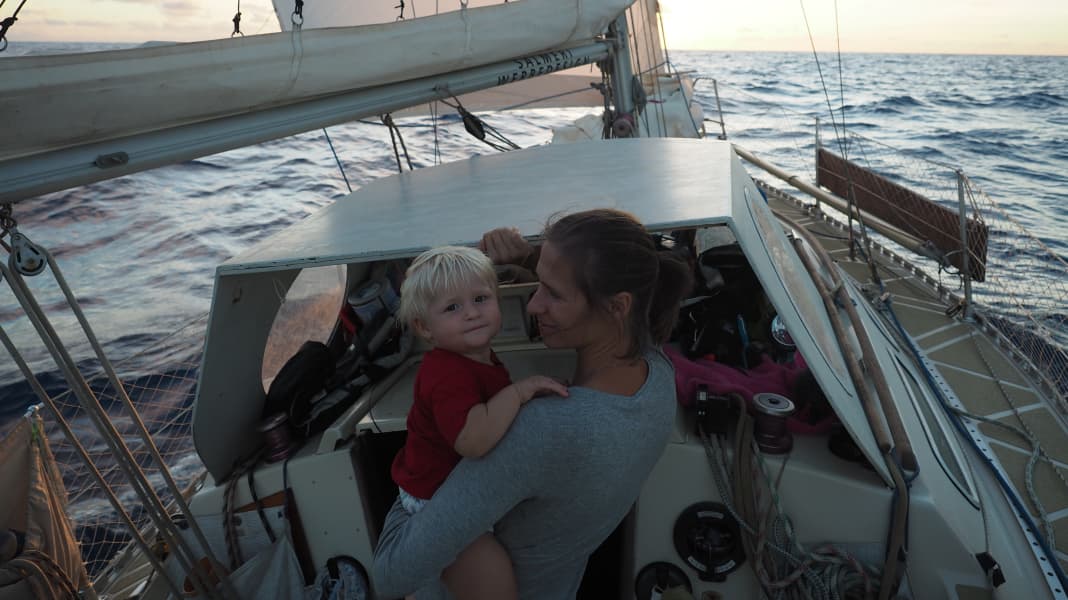
Somewhere in West Africa a year ago. Our "Aracanga" is moored at a buoy in the river, and we are waiting on the shore in a pub that is poorly lit by candlelight due to a lack of electricity for the friendly gentleman with the cotton buds to test us for coronavirus. "Good evening, I'm Ibrahim from the Ministry of Health. Do you have corona?"
"Good evening. Er, I don't think..."
"I think so too. Then we can save ourselves the trouble with the tests. I'll bring you the certificates tomorrow lunchtime."
"All right, then. Thank you."
Ibrahim drives up on time the next day in his battered red 190 and hands us the negative test certificates. We tick one last box on the long list of documents that we have to present when we enter the country on the other side of the Atlantic. Sailing has definitely not become any easier in times of the coronavirus pandemic, nor has it become any more affordable. At the equivalent of 50 euros per certificate - delivery service included - the tests in West Africa are the cheapest and least complicated.
The day before our departure, we officially clear out of Banjul, the capital of The Gambia. We get our passports stamped by immigration and are given no proof of payment from customs for 500 dalasi (around 9 euros), but instead blank exit documents, which we fill in ourselves on the way. "No one has ever asked for official exit documents here," comments the corpulent customs officer, somewhat confused, and pockets the money. In the evening, Ibrahim gives us the results of our dodgy coronavirus test from the day before, and back on board we print out all the health and clearance documents several times so that entry on the other side of the Atlantic will hopefully go smoothly.
Clearing out - crossing the Atlantic - clearing in. That was once upon a time. Today it's all about filling out health questionnaires - completing an online clearance - filling out an arrival notice - taking a PCR test max. 72 hours before departure - clearing out - sailing and taking your body temperature every day - taking a PCR test - quarantine until the results are in - clearing in.
24 wonderful, beautiful days at sea
The first part of the paper war is behind us, now we can get going. We chug past Banjul via side arms onto the Gambia River, as we have done several times in recent years. But this time with the crucial difference that in Banjul we don't turn to starboard upriver, but to port towards the Atlantic. We continue through the estuary for a few more miles, but don't change course too soon, otherwise the journey will end on the extensive sandbanks, and then head west.
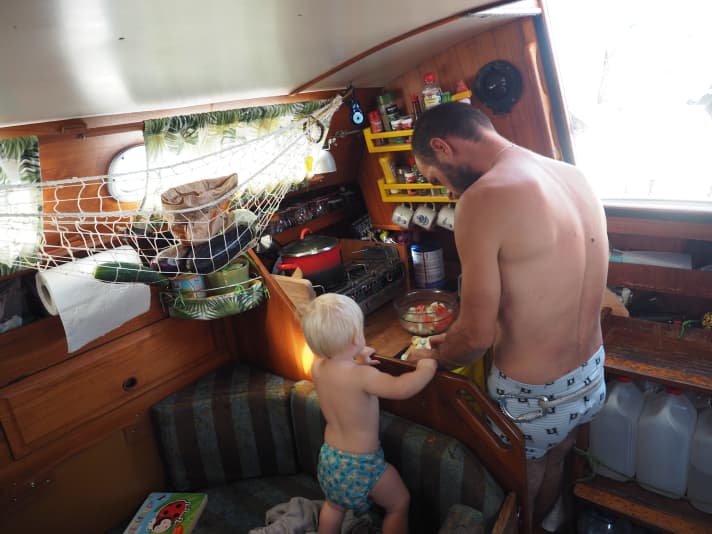
The weather forecast looks good, with 15 to 20 knots of wind and around two metres of waves predicted for the first four days, so the conditions are good. During this time, we want to sail on a west-south-west course to 12 degrees south in order to avoid the 35 knots of wind and four metre waves that are forecast.
The plan works out well, although the first few days are not exactly what you would call pleasant sailing, as the wind is blowing from the north-west instead of the forecast north-east and the waves are a little stronger than predicted, but we make good progress. After the first night, we are also out of the area of the local pirogue fishermen with their countless nets, flashing lights and laser pointers and can take a more relaxed approach to the night watches.
On the second day of the Atlantic crossing, all three of us are hit with seasickness. Kira has to vomit twice while the waves crash against the side of the ship and make staying in the cockpit a wet affair. The start of this part of the journey can't be described as particularly pleasant, it's a typical situation that makes you question the whole endeavour. "Who came up with this rubbish, sailing across the Atlantic for weeks in a nutshell?" These moments do happen. Fortunately, they are rare, and fortunately you can usually laugh about them shortly afterwards.
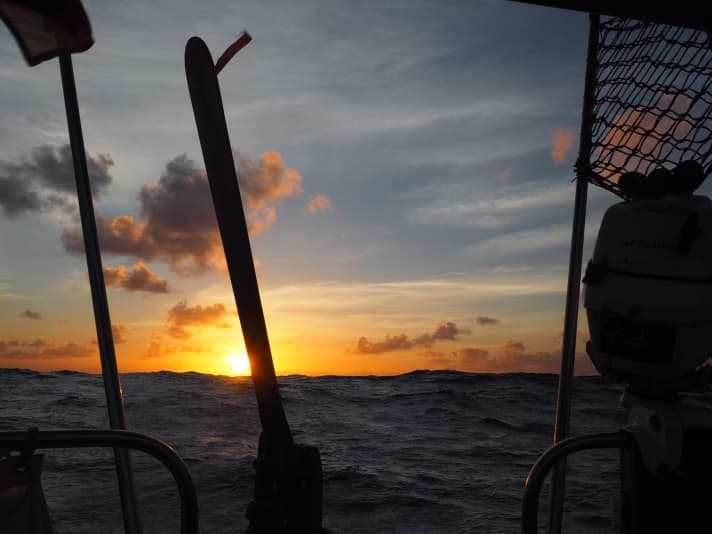
But if the baby throws up in your lap when you're seasick, you're not feeling well yourself, the hatch is leaking over your fresh clothes, caterpillars are roping down from the aubergines in the vegetable net onto your pillow, salt water is sloshing around in the bilge, the new water maker is producing problems instead of fresh water, another three weeks at sea are to be expected and you want to make yourself some cocoa as a consolation, which then spreads across the galley in the next wave, then this can sometimes lead to a spontaneous outburst of rage.
Fortunately, this paragraph in no way reflects our Atlantic crossing, but only a brief moment that is just as much a part of it as all the beautiful and unforgettable experiences of the crossing. The problem with the caterpillars is quickly solved, the problem with the watermaker is a little more complicated, but just as solvable. And fortunately, the water in the bilge does not come through the keel-hull connection as feared but, as it turns out later, from the foot of a railing support.
Once we reach our waypoint at 12 degrees south, the wind picks up to around 25 to 30 knots. Further north, the wind is much stronger. The wind doesn't bother us, but a short, steep wave from the north gives us another good shake and makes life on board uncomfortable. The good thing is that we make fast progress and make over 120 miles a day during these days, which is a good distance for our small 30-foot boat.
The sea glows eerily and beautifully in the crests of the breaking waves, twice one of them enters the cockpit and fills it up like a bathtub. We prefer to stay below deck.
We are also so far away from the main shipping routes here that we sleep during the nights and only check the course every now and then at night. If another ship approaches, the AIS alarm warns us. However, it doesn't sound once during the entire journey. We only see one other ship that crosses our course at dusk and comes within half a mile. Otherwise we are alone. The most exciting thing that happens during these days is a bang in the night and a broken steering line on our windvane steering, which is quickly repaired.
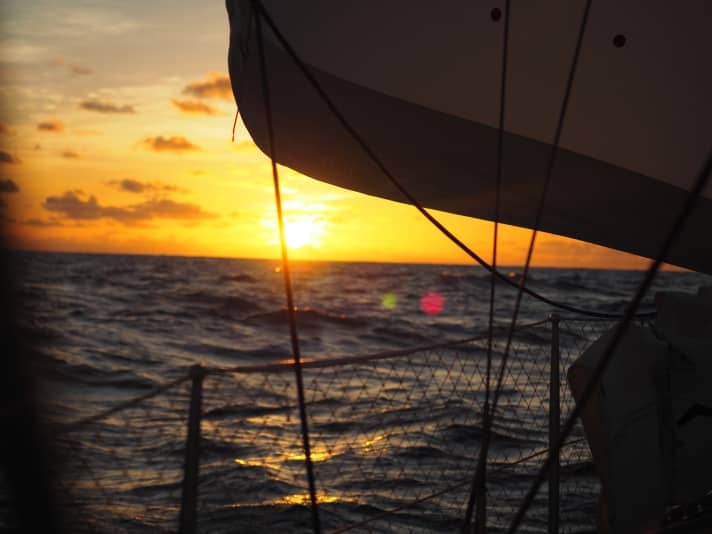
Our living space below deck is about 2.5 by 2.5 metres. The bow cabin is full of SUPs and fruit, and the dog bunk has become a storage area for all sorts of things. Kira and Riki sleep on the U-shaped seating area on the starboard side, which has been converted into a sunbathing area and takes up most of our limited living space, and I sleep on the longitudinal berth on the port side in the saloon. The U-shaped seating area is secured with a leeboard so that nobody falls out of bed and Kira and her Duplo bricks don't roll through the boat, leaving only the bench on the port side for seating during the day. It looks similar on deck: The jib is attached to the cutter stay and tied to the railing, the storm jib lies ready in the sail bag and the dinghy is rolled up behind the mast.
Fortunately, after about ten days the weather becomes much more pleasant and we spend a lot of time in the cockpit, where it is now mostly dry and only rarely a wave comes in. Everyday life on board settles in and sailing is just as it should be: wonderful and pleasant.
Sometimes it's a bit tiring, of course, but that has less to do with sailing and more to do with a one-year-old who demands constant attention, especially with a boat labouring in the waves. The days when a crossing couldn't be long enough are just about over. We enjoy sailing, but we also look forward to arriving, and we feel Kira's urge to move. The calm and relaxed crossing life is now only experienced during the two hours when Kira takes her afternoon nap. But she is also getting used to life on the crossing, and the shared fun factor clearly outweighs the stressful moments.
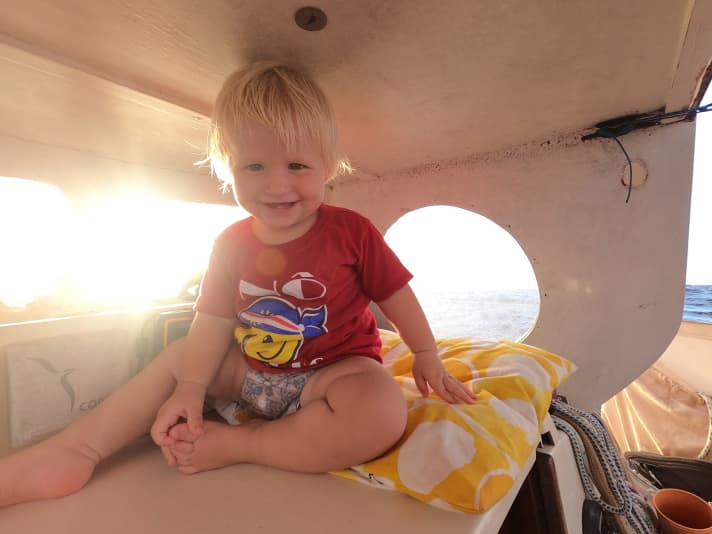
Kira's favourite place during the Atlantic crossing is on the closed sliding hatch under the dodger. She sits there every evening before going to bed, watches the sunset through the salt-encrusted windscreen and rocks her bum to the music from the Bluetooth box. Later, when she is asleep, we can see the Big Dipper and the North Star over the horizon to the north and the Southern Cross on the opposite side. Now it's time for a sundowner, and every now and then we treat ourselves to a sip of wine.
Wednesday and Sunday are the days when we use the satellite phone to make a quick call to the family. The position and the most important things are relayed, detailed phone calls have to wait until after the Atlantic crossing, the charges are too expensive. With the satphone, we also have the luxury of receiving a weather report every other day. Just as regular as the phone calls are the washing days, when our washing machine is unpacked in the form of a large net and Kira's cloth nappies are dragged behind the boat for an hour, the pre-wash cycle so to speak, before they are then washed with a washboard and precious fresh water.
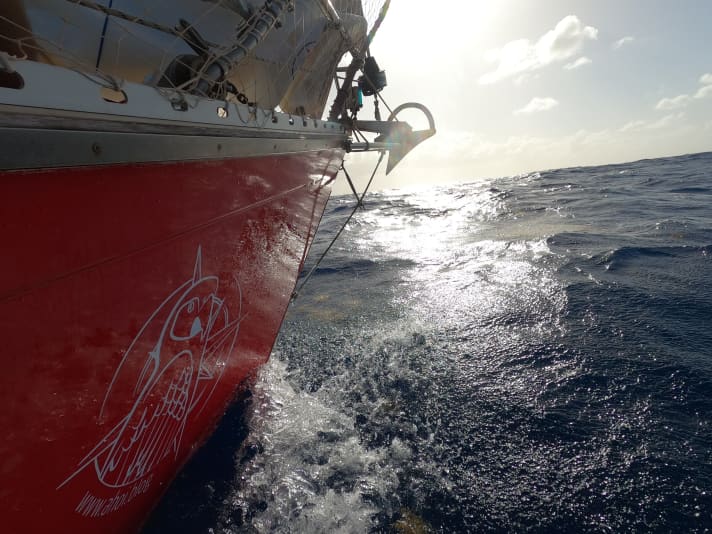
The fruit and vegetables we buy before departure last until the last day of the crossing. In terms of catering, we can't complain - we cook up the wave every day. If at the beginning of the trip we only have oatmeal in the morning and something very simple and warm in the afternoon, our meal plan soon looks like this: breakfast is followed by a second breakfast in the form of pasta or rice from the previous day fried with onions and egg, then something to nibble on, fruit in the afternoon, a warm meal later on and a piece of chocolate for a sundowner.
The days come and go, and if we didn't write a logbook, we would no longer have any sense of time. After 15 days at sea, we crack the 1,000-mile mark. 1,750 miles are behind us. From now on, the distance is in three digits and time feels like it's going faster.
The sea is getting warmer by the day and we are looking forward to having a coffee in peace, jumping into the water and playing with Kira on the beach. Four days before arrival, she discovers her flip-flops and doesn't want to take them off, just like her little rucksack. So we spend hours below deck, where the little one wants to walk around the boat with her shoes and rucksack. Three metres from the companionway to the bow cabin and back again. And back and forth and back and forth and, and, and. Of course, the whole thing only works by hand because of the wave, so one of us is forced to wobble through the boat as well. Tiring, but accompanied by lots of laughter.
Laaand in sight!
On the night of 24 March, the lights of Grenada appear on the horizon. We make much better progress than expected over the last few miles, and by the morning we are sailing along the south coast of the island and round the corner to Saint George's, where we drop anchor.
24 days, 2,750 nautical miles and an Atlantic crossing are behind us. There are a few things on the "looking forward to it" list that we do straight away: a coffee, a dip in the sea and, since we are in the Caribbean, a glass of rum.
Then, due to the lack of a functioning outboard motor, we paddle the half mile into the harbour for an hour against 25 knots of wind with a dinghy that is, to put it mildly, damaged after two years of African heat and a screaming child, in order to do our PCR tests there. In our luggage we have the tablet with the recorded route (we have to prove the days at sea to avoid quarantine), our logbook with the daily body temperature entries and all the documents such as the negative corona tests from Gambia and the now completed exit documents from customs.
What a difference clearing in is compared to leaving the country on the other side of the Atlantic: strict tests are carried out here, distance and mask rules are adhered to, and nobody comes ashore without a negative test result. Zack, a cotton swab in the nose and then back on the boat. "We'll let you know when the results are in." We wait on board for three days until our PCR tests are analysed.
We will probably have to wait a little longer for the longed-for quiet anchorage, as there is a somewhat unpleasant swell from the north-west at the quarantine anchorage off the capital Saint George. Then finally the call: "Your results are in, you can clear in." In contrast to the repeated paddle tour from on board to shore, clearing in is quick and uncomplicated, and an hour later we have our stamps for three months in our passports.
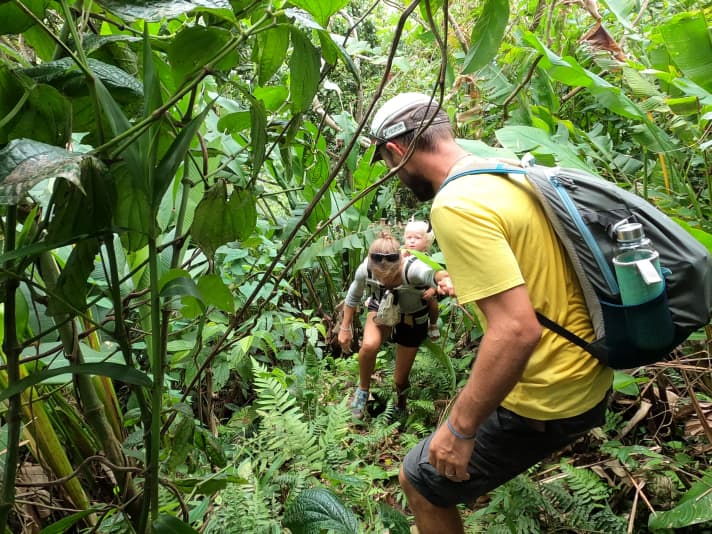
We take a stroll through the town and are pleased to have arrived. The solid ground under our feet is unfamiliar and a little spongy for the first few metres. Kira, on the other hand, who learnt to walk in The Gambia and did a great job of balancing out the waves with her steps on the crossing, falls over like a sack of rice and has to learn to walk again. At the next supermarket, we buy some local fruit and a bottle of Grenadian rum, which we use in the evening to toast the next chapter of our journey: the Caribbean.
Squalls instead of sunshine
Early the next day, it's time to weigh anchor. We motor against the very strong wind and high waves around the south-west tip of the island into an anchorage bay on the south coast of Grenada. We fight our way through the water at 4.5 knots and less than one knot over the ground. In front of our actual destination, the breakers on the rocks and the reef pile up so violently that we decide at short notice to turn into the neighbouring bay. The anchor drops in the narrow passage between Grenada and an offshore island, but instead of 30 degrees and sunshine, it's 30 knots and rain, sometimes 40 knots and even small hailstones.
So this is the Caribbean. One squall after another passes over the island and we are glad to be in a sheltered anchorage and not at sea, where we have been spared weather like this for 24 days.
A 37-foot decision
A 30-foot boat with a small child is cramped. Cramped and somewhat uncomfortable, but doable, at least for a while. However, as travelling for us is developing more and more from a defined journey to a relatively unlimited way of life, we are already toying with the idea of expanding our boat before the Atlantic crossing. It is not easy to reconcile all our requirements for the potential successor to our faithful "Aracanga". Especially as the whole thing still has to fit into our budget somehow.
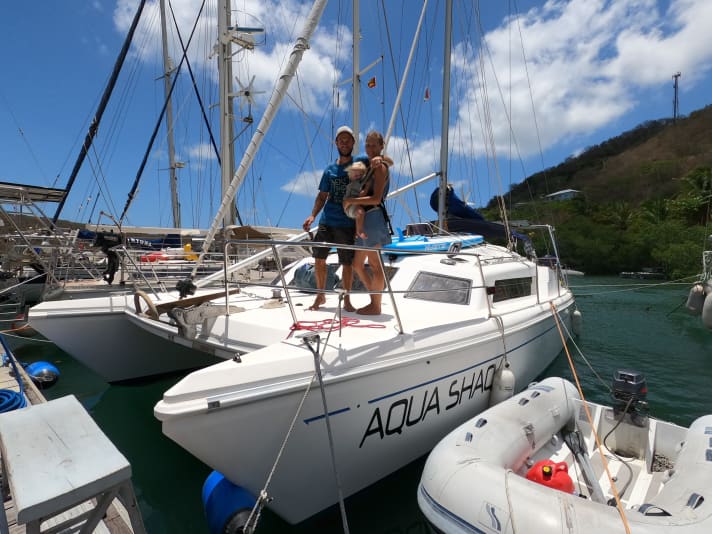
We are looking for older integral keels that fulfil many of our requirements but are usually far too expensive. Another boat is sold faster than we can respond.
Then we find the advert for a Prout 37, a catamaran. A catamaran? It's completely different from the boats we're actually looking for, but it's the only boat that fulfils all our requirements.
It is also considered to be extremely seaworthy and safe. And the longer we look at the boat, the more we like the idea of the small catamaran and we send an email to the sellers. "Come and have a look at her," is the reply. All this is still happening in The Gambia. And that's why we're now in Grenada. We inspect the boat and make a deal.
With a heavy heart, we hang a "For Sale" sign on our red boat. The fear that it would take a long time to find a buyer and that we would have to bear the running costs for two boats for a long time turned out to be completely unfounded. Just a few days later, the "Aracanga" is sold with a handshake, with a very good feeling, to an extremely likeable musician from Wales. He works as a skipper on a large sailing yacht with an uncertain future, is fed up with faulty air conditioning systems, fridges and microwaves and is looking for a small, simple boat to live on.
Our new boat is two metres longer and two metres wider than its predecessor and, as a catamaran, offers significantly more living space. As you would expect, the first few days on the new boat are characterised by chaos. And there is even more room for chaos on the cat than on our little mono.
We didn't just buy a boat, no, we bought a boat full of surprises.
There is no empty locker when you take over the boat. So before we put it away, we have to clear out, clean and sort out. Unfortunately, there's a lot to clean and a lot to clear out, and luckily there's a flea market in a week's time where we can offer a colourful assortment.
We have now been on the new boat for a month and we can say it was a good decision. With the new railing net, Kira can fully utilise the biggest advantage of the catamaran: all the space. From the cockpit to the aft deck, past the superstructure to the height of the shrouds, then in a daring climb onto the roof, slaloming between the hatches to the front and then back on deck on her bum over the windscreens. A short dance of joy follows, then it's back to the shrouds and back to square one.
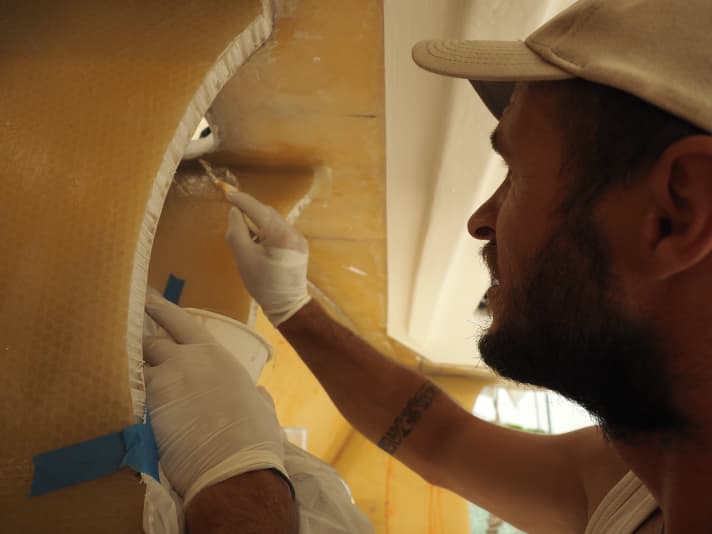
Especially the slide over the windows looks particularly funny from the saloon, with or without a nappy. When the laps around the deck get boring, we either go to the aft deck, point our finger at our dinghy and shout "brummbrumm" loudly, signalling that it's time to go to the beach, or we go into the saloon and point our finger at the fruit net above the galley with the clear request "Mamo" (mango) or "Nane" (banana).
One test drive, two problems, three construction sites
Plans are what you write in the sand at low tide. And after the next high tide, they are gone and you can write new plans in the sand. It's nice to be so flexible, to throw ideas overboard at whim and spin new ones. But unfortunately, it's not always us who decide what happens, which means that some nice plans that you're looking forward to are thrown overboard and end up as a big building site on board. For example, our first planned trip with the new boat: the test trip to the neighbouring island of Carriacou.
The learning curve on the catamaran - it's our first time on one - is steep. But we also quickly learn to appreciate the comforts of the two-hull boat: The side swell doesn't bother us as we lie at a buoy after the first 15 miles sailed. We jump into the water, snorkel around the boat and along the reef and back on board we check the two mooring lines to the buoy again. Everything is fine.
But isn't the anchor winch standing a bit strangely on deck? A look inside the anchor locker, where the motor and gearbox of the winch are located, reveals the problem: the gearbox is broken in two. When we take the winch apart a little later, we realise that apart from the motor, the rest of the part is also completely corroded. So much for the winch having been freshly serviced.
We decide not to get annoyed. As we're actually planning to anchor a lot over the next few weeks, it's wiser to sail back and repair or replace the part before we set off again. We have a sundowner and all is well.
At least for a short time, because when the water pump stops briefly a little later, we discover the next surprise: when cleaning the pump's pre-filter, the wood on which it lies sounds a little funny. So we knock on it a little, and bang goes our thumb through the beautifully varnished wood. Now we're annoyed: the whole piece of wood and, as we realise later, the bulkhead behind it are rotten. Under the compartment and inaccessible from the outside is the mast base, a solid piece of hardwood that is also rotten at the edges. Now there's no point in saying we're not annoyed, now we're annoyed.
Why didn't we realise this during the boat inspection? Quite simply, it wasn't visible, hidden behind walls, floors, beautiful laminate and paintwork.
We only realise the full extent of the problem when we undo a lot of screws, remove fixtures and cupboard backs and hang upside down deep in the bilge. This is our second construction site, against which the broken anchor winch becomes a trifle. Our trip to Carriacou will probably not happen in the next few weeks, so for now it's all about working days. Especially as we still have construction site number three, which we actually wanted to tackle: a dodger and a hardtop.
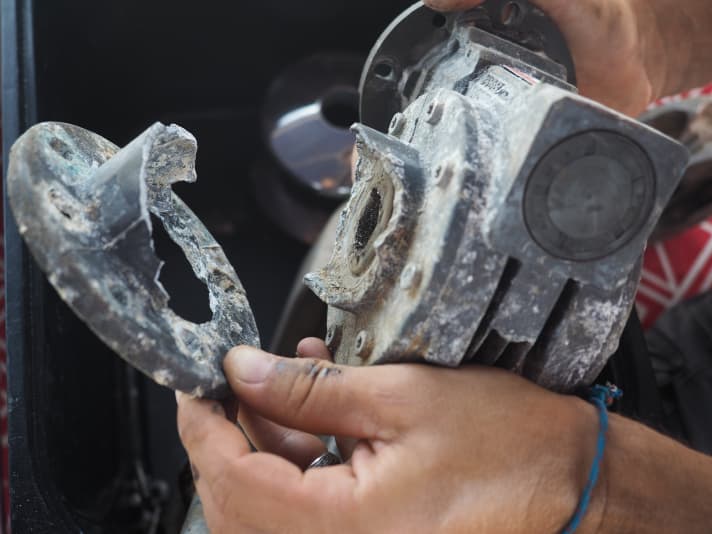
Two days later we tie up to a buoy in our old anchorage due to a lack of windlass, and for the next few months we have to work instead of sail. For the time being, we leave the mast foot as a mast foot and take care of the dodger and hardtop. The reason for this is that our friend Paul, a boat builder by trade, has offered us his help, which we are naturally happy to take up.
Glass fibre and polyester resin
To avoid getting lost in technical details here, we'll keep it short and sweet: the hardtop and dodger, the roof and windscreen so to speak, consist of a plastic core with a honeycomb structure, which is laminated over with glass fibre mats and polyester resin and covered with a gelcoat. We laminate the side panels directly on deck, bend the roof over a frame on a specially made oversized table and finish it completely on land.
We are installing a large hatch above the helm station for better ventilation in the cockpit and to be able to see into the mainsail. Here are a few key figures: We are using five two-and-a-half square metre sheets of core material, plus 60 metres of fibreglass mats, 70 litres of polyester resin, and (as we are normally very environmentally conscious, I really hate to write this) our need for disposable gloves adds up to around 600.
In the end, we put the roof on a floating dock to bring it on board, put everything together on deck, laminate the parts together, cut out the windows, put them in, and after a small millimetre-inch conversion debacle, we finally get the right aluminium supports for the stern.
We are also gradually completing the other construction sites on board: the bow is adorned with a new anchor winch and the mast base has been repaired and reinforced. It is perhaps the strongest mast foot of any Prout Snowgoose ever built. Below deck there are new upholstery covers and sun protection on the windows to provide shade. Then comes the first hurricane of the season, Elsa, but it brings us more rain than wind and the certainty that we have also successfully solved the problem of the leaking windows.
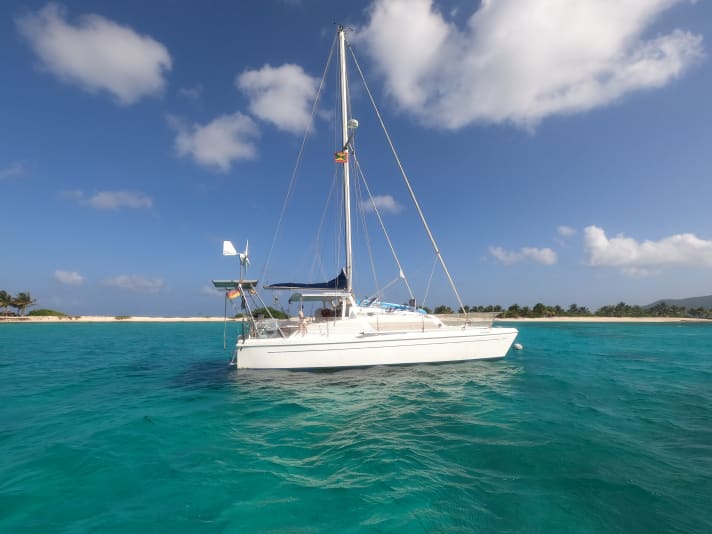
After our working days, we either spend the evening relaxing on board or somewhere where music is playing. There is live music in some bar or other almost every evening. Then Kira is right in the middle of it, with a rattle in her hand or a harmonica in her mouth, happy and dancing. And we're happy too. And sometimes we dance too.
A test drive at last?
More than half a year's work lies behind us. Then the time has finally come: we are ready to sail. So off we go for our first test drive! Unfortunately, it's not that easy. There was still Corona. And with the exponential increase in Covid cases on Grenada in recent days, it was only a matter of time before stricter restrictions came into force.
And the restrictions come one after the other: first the night-time curfew is brought forward from midnight to 9 p.m. and shortly afterwards a quasi-lockdown is announced. We've been here for so long now that a few weeks won't make any difference. So we make ourselves comfortable on board, go swimming a lot and wait until we are finally allowed to set sail.

To be continued.

